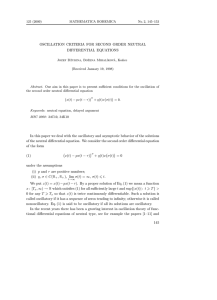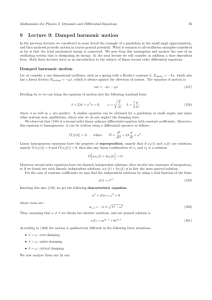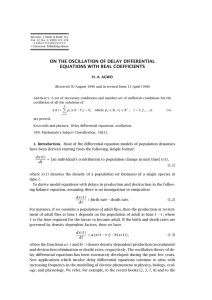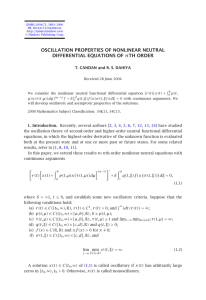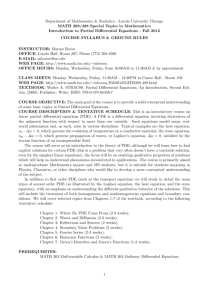ON THE OSCILLATION OF FIRST-ORDER NEUTRAL DELAY IBRAHIM R. AL-AMRI
advertisement
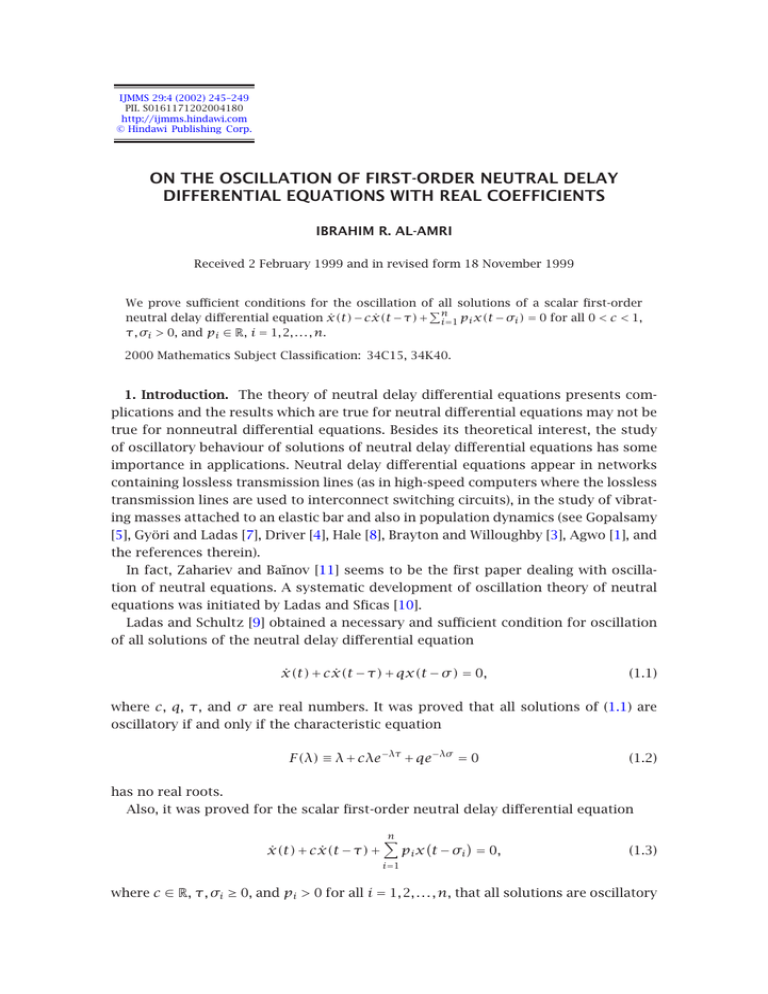
IJMMS 29:4 (2002) 245–249
PII. S0161171202004180
http://ijmms.hindawi.com
© Hindawi Publishing Corp.
ON THE OSCILLATION OF FIRST-ORDER NEUTRAL DELAY
DIFFERENTIAL EQUATIONS WITH REAL COEFFICIENTS
IBRAHIM R. AL-AMRI
Received 2 February 1999 and in revised form 18 November 1999
We prove sufficient conditions for the oscillation of all solutions of a scalar first-order
neutral delay differential equation ẋ(t) − c ẋ(t − τ) + n
i=1 pi x(t − σi ) = 0 for all 0 < c < 1,
τ, σi > 0, and pi ∈ R, i = 1, 2, . . . , n.
2000 Mathematics Subject Classification: 34C15, 34K40.
1. Introduction. The theory of neutral delay differential equations presents complications and the results which are true for neutral differential equations may not be
true for nonneutral differential equations. Besides its theoretical interest, the study
of oscillatory behaviour of solutions of neutral delay differential equations has some
importance in applications. Neutral delay differential equations appear in networks
containing lossless transmission lines (as in high-speed computers where the lossless
transmission lines are used to interconnect switching circuits), in the study of vibrating masses attached to an elastic bar and also in population dynamics (see Gopalsamy
[5], Györi and Ladas [7], Driver [4], Hale [8], Brayton and Willoughby [3], Agwo [1], and
the references therein).
In fact, Zahariev and Baı̆nov [11] seems to be the first paper dealing with oscillation of neutral equations. A systematic development of oscillation theory of neutral
equations was initiated by Ladas and Sficas [10].
Ladas and Schultz [9] obtained a necessary and sufficient condition for oscillation
of all solutions of the neutral delay differential equation
ẋ(t) + c ẋ(t − τ) + qx(t − σ ) = 0,
(1.1)
where c, q, τ, and σ are real numbers. It was proved that all solutions of (1.1) are
oscillatory if and only if the characteristic equation
F (λ) ≡ λ + cλe−λτ + qe−λσ = 0
(1.2)
has no real roots.
Also, it was proved for the scalar first-order neutral delay differential equation
ẋ(t) + c ẋ(t − τ) +
n
pi x t − σi = 0,
(1.3)
i=1
where c ∈ R, τ, σi ≥ 0, and pi > 0 for all i = 1, 2, . . . , n, that all solutions are oscillatory
246
IBRAHIM R. AL-AMRI
if and only if the characteristic equation
F (λ) ≡ λ + cλe−λτ +
n
pi e−λσi = 0
(1.4)
i=1
has no real roots. This result was generalized by Arino and Györi in [2] for pi ∈ R.
In [6], Gopalsamy and Zhang proved that, if
(1) 0 < c < 1,
(2) τ ≥ 0, σ > 0, p ≥ 0,
(3) peσ > 1 − c(1 + τp/(1 − c)),
then every solution of
ẋ(t) − c ẋ(t − τ) + px(t − σ ) = 0
(1.5)
is oscillatory.
In this paper, we extend the last result for a scalar first-order neutral delay differential equation in the form
ẋ(t) − c ẋ(t − τ) +
n
pi x t − σi = 0
(1.6)
i=1
for all 0 < c < 1, τ, σi ≥ 0, and pi ∈ R, i = 1, 2, . . . , n.
Let γ = max{t, σ1 , σ2 , . . . , σn } and let t1 ≥ t0 . By a solution of (1.6) on [t1 , ∞) we
mean a function x(t) ∈ C([t1 − γ, t1 ], R) such that x(t) − cx(t − τ) is continuously
differentiable and (1.6) is satisfied for t ≥ t1 .
As it is customary, a solution is called oscillatory if it has arbitrarily large zeros and
otherwise, it is called nonoscillatory.
2. The main result. Consider (1.6) and assume that pki ≥ 0 for all i = 1, 2, . . . , and
pmj < 0 for all j = 1, 2, . . . , r with + r = n. Let qmj = −pmj , j = 1, 2, . . . , r , then (1.6)
takes the form
ẋ(t) − c ẋ(t − τ) +
r
pki x t − τki −
qmj x t − σmj = 0
i=1
(2.1)
j=1
or simply
ẋ(t) − c ẋ(t − τ) +
i=1
r
pi x t − τi −
qj x t − σj = 0,
(2.2)
j=1
where 0 < c < 1, τ, σi , pi ≥ 0, and τi , qj > 0 for all i = 1, 2, . . . , and all j = 1, 2, . . . , r
with + r = n.
Theorem 2.1. Consider the neutral delay differential equation (2.2). If
r
(i) pi > j=1 qj for all i = 1, 2, . . . , ,
r
(ii)
i=1 (1 − c − j=1 qj (τi − σj )) ≥ 0,
r
r
(iii) (e + cτ/(1 − c)) i=1 (pi − j=1 qj )τi > i=1 ((1 − c) − j=1 qj (τi − σj )),
then all solutions of (2.2) are oscillatory.
247
ON THE OSCILLATION OF FIRST-ORDER NEUTRAL DELAY . . .
Proof. The characteristic equation of the neutral delay differential equation (2.2) is
F (λ) ≡ λ − cλe−λτ +
pi e−λτi −
i=1
r
qj e−λσj = 0.
(2.3)
j=1
Assume that (2.2) has a nonoscillatory solution, then the characteristic equation (2.3)
has a real root λ0 , that is,
r
pi e−λ0 τi −
qj e−λ0 σj = 0.
F λ0 ≡ λ0 − cλ0 e−λ0 τ +
i=1
(2.4)
i=1
But for all λ ∈ R, one can write
λ1 − ce−λτ −
r
qj e−λσj
τi −σj
j=1
= λ − λce−λτ +
e−λs ds
0
r
qj e−λ(τi −σj ) − 1 e−λσj
(2.5)
j=1
= λ − λce−λτ −
r
qj e−λσj + e−λτi
j=1
r
qj
j=1
for all i = 1, 2, . . . , and then
λ1 − ce−λτ −
i=1
r
qj e
−λσj
e
−λs
ds
0
j=1
= λ − λce−λτ −
τi −σj
r
j=1
qj e−λσj +
e−λτi
i=1
r
(2.6)
qj .
j=1
From (2.3) and (2.6), one can write
τi −σj
r
r
1
−λσj
−λτ
−λs
λ 1 − ce
−
qj e
e
ds +
qj e−λτi
pi −
F (λ) =
i=1
0
j=1
i=1
j=1
(2.7)
for all λ ≥ 0, we have
r
r
1
pi −
F (λ) >
λ 1−c −
qj τi − σj +
qj e−λτi .
i=1
j=1
i=1
j=1
(2.8)
r
r
Since pi > j=1 qj for all i = 1, 2, . . . , and i=1 (1−c − j=1 qj (τi −σj )) ≥ 0, it follows
that F (λ) > 0 and consequently F (λ) has no positive or zero real roots.
From (2.7), we have
τi −σj
r
r
1
−λσ
−λτ
−λs
−λτ
1−ce
pi −
j
− qj e
e
ds+
qje i . (2.9)
F (λ) = λ
λ
0
i=1
j=1
i=1
j=1
248
IBRAHIM R. AL-AMRI
In order that F (λ) has no roots for all λ < 0, we prove that F (λ) > 0 for all λ < 0 and
consequently it is enough to prove that
1 − ce
−λτ
−
i=1
r
qj e
−λσj
e
−λs
0
j=1
r
1
pi −
ds < −
qj e−λτi .
λ i=1
j=1
τi −σj
(2.10)
Assume that −λ = µ and put
f1 (µ) =
1 − ce
µτ
−
i=1
r
qj e
µσj
j=1
τi −σj
e
µs
ds ,
0
(2.11)
r
eµτi
pi −
f2 (µ) =
qj
.
µ
i=1
j=1
r
r
Since pi > j=1 qj for all i = 1, 2, . . . , , then f2 (µ) > e i=1 (pi − j=1 qj )τi . We
construct a function f in between f1 and f2 such that f2 − f > 0 and f − f1 > 0.
r
Assume that f (µ) = (1 − c − cµτ) − i=1 j=1 qj (τi − σj ).
Then,
τi −σj
r
r
µσ
µτ
µs
1 − ce −
qj τi − σj −
qj e j
e ds
f − f1 = (1 − c − cµτ) −
i=1 j=1
=
1 − ceµτ −
i=1
r
qj e
µσj
i=1
j=1
0
τi −σj
e
µs
ds
0
j=1
τi −σj
r
µτ
µσj
µs
> 0,
c e − 1 − µτ +
qj e
e ds − τi − σj
=
0
i=1
f2 − f =
∀µ > 0,
j=1
gi (µ),
i=1
(2.12)
where
gi (µ) = pi −
r
j=1
qj
eµτi
µ
− (1 − c − cµτ) +
r
qj τi − σj ,
i = 1, 2, . . . , .
(2.13)
j=1
Since eµτi /µ has a minimum value at µ = 1/τi , then eµτi ≥ eτi , for all µ > 0, i =
1, 2, . . . , . Hence,
r
r
τ
+ qj τi − σj , i = 1, 2, . . . , qj ατi ei/α − 1 − c − c
gi (µ)|µ=1/ατi = pi −
ατ
i
j=1
j=1
r
qj ατi − (1 − c), α ≥ 1.
> pi −
j=1
(2.14)
ON THE OSCILLATION OF FIRST-ORDER NEUTRAL DELAY . . .
249
For
1−c
,
r
α> pi − j=1 qj τi
i = 1, 2, . . . , ,
(2.15)
we have, gi (µ) > 0 for µ ∈ (0, 1/ατi ). It follows that gi (µ) > 0, for all µ ∈ (0, (pi −
r
r
j=1 qj )τi /(1 − c)). We now consider µ ≥ (pi − j=1 qj )τi /(1 − c) and note that
r
r
cτ
pi −
(1 − c) −
τi −
qj e +
qj τi − σj > 0, (2.16)
f2 − f µ ≥
1−c
i=1
j=1
i=1
j=1
since,
cτ
e+
1−c
i=1
pi −
r
j=1
qj τi >
(1 − c) −
i=1
r
qj τi − σj .
(2.17)
j=1
Example 2.2. Consider the neutral delay differential equation in the form
3π
d
x(t) − cx(t − 2π ) + x(t − 4π ) − x(t − 2π ) + (1 − c)x t −
= 0.
dt
2
(2.18)
This equation has an oscillatory solution x(t) = sin t but not all solutions are oscillatory since the sufficient conditions—in Theorem 2.1—are not satisfied. In fact, it has
a nonoscillatory solution x(t) = e−λt , 0.0608314 < λ < 0.0608315.
References
[1]
[2]
[3]
[4]
[5]
[6]
[7]
[8]
[9]
[10]
[11]
H. A. Agwo, On the oscillation of delay differential equations with real coefficients, Int. J.
Math. Math. Sci. 22 (1999), no. 3, 573–578.
O. Arino and I. Györi, Necessary and sufficient condition for oscillation of a neutral differential system with several delays, J. Differential Equations 81 (1989), no. 1, 98–105.
R. K. Brayton and R. A. Willoughby, On the numerical integration of a symmetric system
of difference-differential equations of neutral type, J. Math. Anal. Appl. 18 (1967),
182–189.
R. D. Driver, A mixed neutral system, Nonlinear Anal. 8 (1984), no. 2, 155–158.
K. Gopalsamy, Stability and Oscillations in Delay Differential Equations of Population Dynamics, Kluwer, Dordrecht, 1992.
K. Gopalsamy and B. G. Zhang, Oscillation and nonoscillation in first order neutral differential equations, J. Math. Anal. Appl. 151 (1990), no. 1, 42–57.
I. Györi and G. Ladas, Oscillation Theory of Delay Differential Equations, Oxford Mathematical Monographs, Clarendon Press, New York, 1991.
J. K. Hale, Theory of Functional Differential Equations, Springer-Verlag, New York, 1977.
G. Ladas and S. W. Schults, On oscillations of neutral equations with mixed arguments,
Hiroshima Math. J. 19 (1989), no. 2, 409–429.
G. Ladas and Y. G. Sficas, Oscillations of neutral delay differential equations, Canad. Math.
Bull. 29 (1986), no. 4, 438–445.
A. I. Zahariev and D. D. Baı̆nov, Oscillating properties of the solutions of a class of neutral
type functional-differential equations, Bull. Austral. Math. Soc. 22 (1980), no. 3,
365–372.
Ibrahim R. Al-Amri: Department of Mathematics, Faculty of Science, King Abdulaziz
University, P.O. Box 30010, Madinah Munawarah, Saudi Arabia
